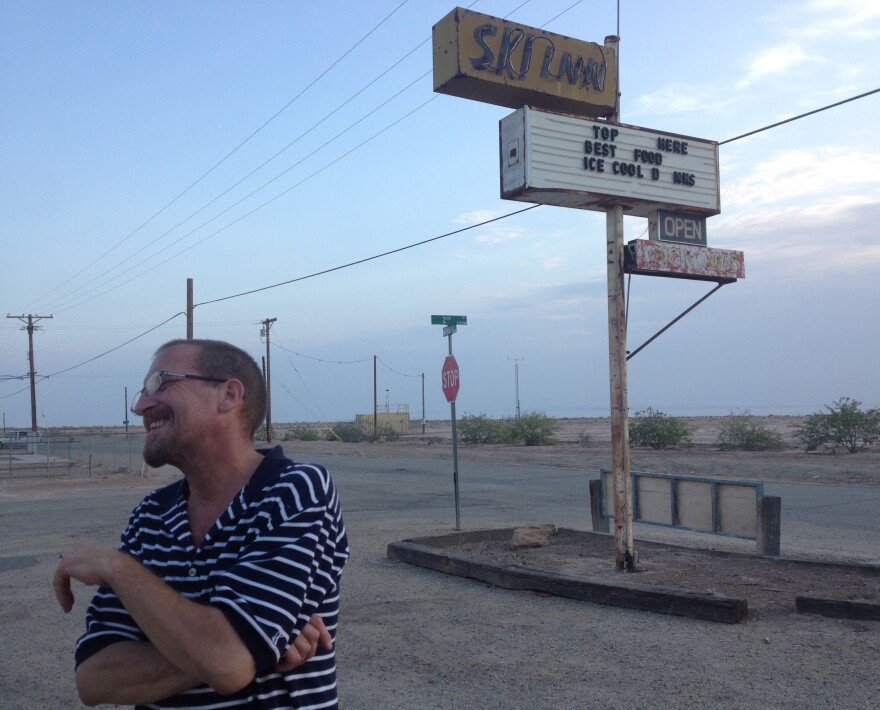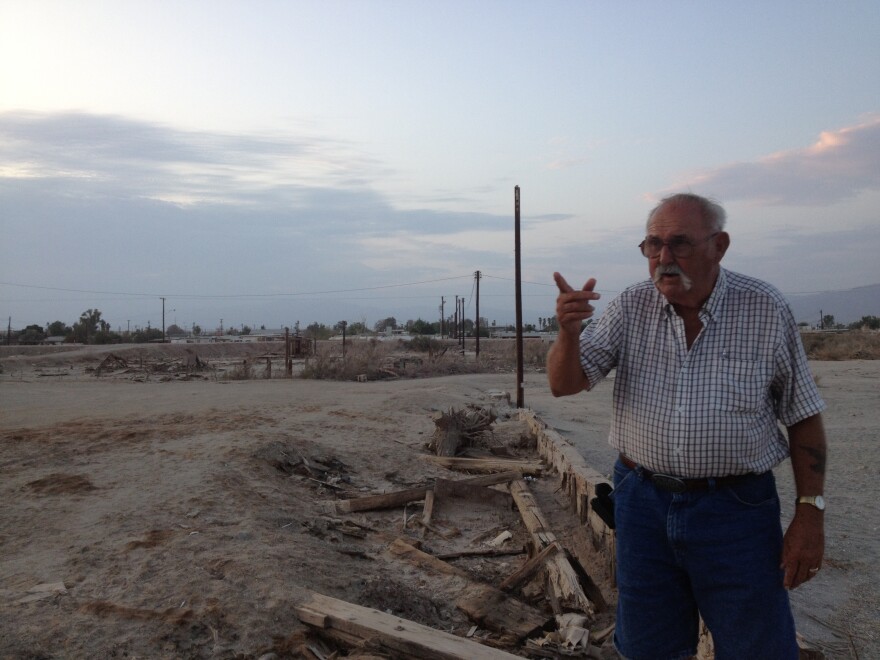What would the end of the world look like? Writer Chris Killian of Kalamazoo may have seen it. While roaming the nation from coast to coast looking for the stories of ordinary Americans, he found Bombay Beach. He sends this audio postcard from the forlorn former resort town on the shore of southern California’s Salton Sea. Read more at his blog Types of America.
At first glance, Bombay Beach looks like a corpse that’s had its flesh ripped clean off, the skeleton left to bake and rot in the flaming desert sun.
It’s 103 degrees on a mid-July afternoon and not a soul is around, just a few barking dogs shouting at each other across a great distance. Most of the homes are crumbling, windswept shells, their insides strewn with items left before a hasty split. Boats tipped upside down sit dry-docked in a sea of weeds on abandoned lots and all of it is tagged with graffiti. Everything is coated by a thick stench you can’t help but feel like you’re inhaling. The ruin looks almost too perfect so as to be artificial, like this town in the California desert is a set for some Mad Max-type thriller. In fact, it is a go-to destination for filmmakers looking to shoot scenes of what the world might look like when something catastrophic wipes out humanity. But, in reality, people do live here in homes that look out of place amid the rubble.

At the Ski Inn, the only bar in town, Steve Johnson sits under a row of black and white pictures that frame the hardscrabble scene outside. He’s seen the filmmakers and the photo-taking hipsters drive in from L.A. to soak-up the place, write their own lines in what he calls the “poetry of decay,” but never bother to talk to anyone to put some meat back on the bones of Bombay Beach, then getting back onto Highway 111 with the same ideas they came in with.
Johnson says, “People are really dismissive and a little snarky, especially the L.A. people that come out here. Just because you’re poor doesn’t mean you’re irrelevant. People that do the documentaries and whatever they take away from this place, they bring their preconceptions. And that’s what they leave with: their preconceptions. If they’re so dismissive of the irrelevant people…who would want to live here? So they bring that with them. Who would want to live here? If they want to live here, we don’t really care about them but it’s a weird place and we want to take pictures of it.”
Bombay Beach would not be here if it were not for the Salton Sea, the largest lake in the state and one of the lowest points of the country. The sea was formed after an engineering mistake caused the Colorado River to flow into the area in the early 1900s. In a few years the basin filled-up and the lake was born, a body of water now saltier than the Pacific and home to a rich amount of biodiversity.
The story of Bombay Beach, like nearly all shore towns, has been tied to the water. From the 1950s through the 1980s the town boomed, with developers constructing marinas and bars and resorts along the shoreline. It was billed as an American Riviera, an oasis in the middle of the desert where vacationers water-skied and sport-fished.
Then the sea flooded, ruining most of the action along its shores. Now the lake levels are falling because less water is flowing into the lake and because of ever increasing water demand from Los Angeles and San Diego. It’s possible that, in several years, the lake could disappear.

Outside the Ski Inn, I meet Bruce Wayne, a 28-year resident who goes by the nickname “Wacko” because of the wild life he used to live when his breakfast was three screwdrivers. Like most people in Bombay Beach, he uses a golf cart to get around and we hop in the thing and head south along Avenue A in the direction of the sea, driving along a high berm that used to keep the water out of town but now just provides a sad vantage point. When we get to the water’s edge, Bruce points to where old bars and marinas sat, places with names like “Barco’s” and “Luck of the Irish.” Now everything between the berm and the sea is destroyed, the structures encased in a thick coating of salt, preserving them in a way.
Wayne has his own reasons for staying in Bombay Beach. “I don’t like the big city, you know, the big city life. All my friends are here. Like I said, most of them are old timers and are gone now, what’s left. All my kids were raised here, more or less. I just don’t like the hustle and bustle of the big town.”
We drive away, and down a gully a man is wrapping a heavy chain around a hulking piece of metal. “Looks like he’s stealing something,” Bruce says. Stuff like that happens all the time. People are just hanging on here but they survive.
I think to myself that sometimes things that never should have been, never should have been. I wonder if it would have been better if Bombay Beach, even the Salton Sea, had never existed. But Bruce drops me off back at the Ski Inn and I talk again to Steve, who's standing outside surrounded by a swarm of flies.
"You get along. You have a house, you have a home and you wake up and you eat and you work, and you eat and you work and you eat and you live. It’s the same as anywhere else.”
I hop onto the highway and head north, the town disappearing in the rearview mirror. Behind me are Bruce, Steve and 293 other people who've have made a home in the most unlikely of places.

